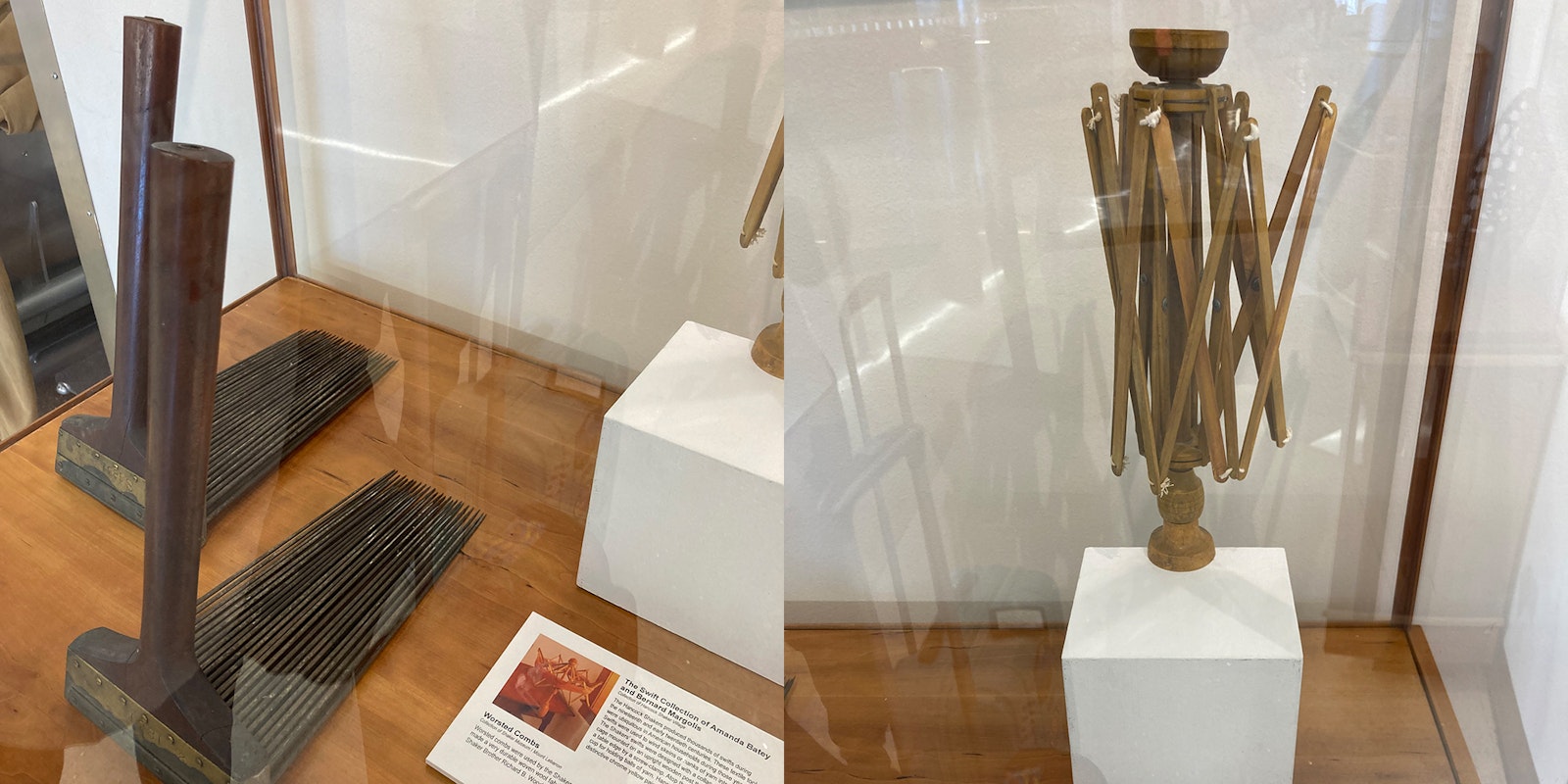August 6, 1774
Mother Ann Lee the leader of the United Society of Believers in Christ’s Second Appearing, or Shakers, and some of her followers arrive in New York from England.
Here’s the needlework connection to this date:
Seeking freedom of religion, Ann Lee, left England to establish the United Society of Believers in Christ’s Second Appearing in the United States, a religious group founded in the eighteenth century. The members of the group were commonly referred to as “Shakers” because of their exuberance during worship. The members believed in celibacy, justice, equality, and a communal life.
 Centre Family Dwelling at Shaker Village at Pleasant Hill, Kentucky. Photo by Tom Allen/Wikimedia Commons
Centre Family Dwelling at Shaker Village at Pleasant Hill, Kentucky. Photo by Tom Allen/Wikimedia Commons
Although the items—crafts, furniture, buildings, tools—the Shakers made were utilitarian, they also were exquisite with meticulous attention to detail. At present, only two Shakers are still alive—Sister June and Brother Arnold continue to live and work at the Sabbathday Lake Shaker Village in New Gloucester, Maine. Rohn Strong wrote an article for the November/December 2015 issue of PieceWork on Shaker Christmas traditions. The following is from that article:
 Chair at Canterbury Shaker Village in Canterbury, New Hampshire. Photograph in Carol M. Highsmith's America Project in the Carol M. Highsmith Archive, Library of Congress, Prints and Photographs Division
Chair at Canterbury Shaker Village in Canterbury, New Hampshire. Photograph in Carol M. Highsmith's America Project in the Carol M. Highsmith Archive, Library of Congress, Prints and Photographs Division
- The Shakers were founded in 1747 in Manchester, England. In 1774, after a short incarceration for her beliefs, Mother Ann Lee (1736–1784) led the Shakers to their new home in Colonial America. Upon arriving, and for nearly thirteen years after, the Shakers faced unprecedented odds while trying to evangelize and expand their numbers. Although the growth was slow at first, the numbers did expand and grew to about 5,000 members in twenty Shaker communities.
- Handcrafts, including knitting, were important to the Shakers, and it is easy to surmise that these handmade items were exchanged during Christmas. Some members were prolific knitters. They knitted socks, mittens, gloves, shawls, cushions, wristlets, fingerless mitts, rugs, washcloths, and stockings from linen, cotton, and wool. The items they created benefited the community and were sold in shops to the “world’s people.”
- In Susan Strawn’s book Knitting America: A Glorious Heritage from Warm Socks to High Art, she writes, “In 1838, for example, one order of sisters in Watervliet, New York, knit forty pairs of stockings and sixty five pairs of ‘footings’ (the foot part of the stocking).” The needles used often measured less than 2 millimeters (a modern-day size 00). Such fine needles produced a fabric averaging between 40 and 50 stitches per 4 inches (about 20 and 30 stitches per cm).
 Bedroom at Canterbury Shaker Village in Canterbury, New Hampshire. Photograph in Carol M. Highsmith’s America Project in the Carol M. Highsmith Archive, Library of Congress, Prints and Photographs Division
Bedroom at Canterbury Shaker Village in Canterbury, New Hampshire. Photograph in Carol M. Highsmith’s America Project in the Carol M. Highsmith Archive, Library of Congress, Prints and Photographs Division
Ann Lee died in 1784 at the age of forty-eight at the Shaker settlement of Watervliet in Colonie, New York.
In his article, Rohn included the list below of Shaker Villages and Museums; many of these have shops selling traditional Shaker crafts and furniture.
 Shaker sampler made by Mariah Boil (born 1832) in Pleasant Hill, Kentucky. 1844. Collection of The Metropolitan Museum of Art, New York, New York; purchase, Edward J. Scheider gift, in memory of Kathleen N. Scheider, and David S. and Elizabeth W. Quackenbush gift. (2008.453). Photo courtesy of The Metropolitan Museum of Art
Shaker sampler made by Mariah Boil (born 1832) in Pleasant Hill, Kentucky. 1844. Collection of The Metropolitan Museum of Art, New York, New York; purchase, Edward J. Scheider gift, in memory of Kathleen N. Scheider, and David S. and Elizabeth W. Quackenbush gift. (2008.453). Photo courtesy of The Metropolitan Museum of Art
Interested in learning about more gift-giving traditions? This full article and others can be found in the November/December 2015 issue of PieceWork.
Also, remember that if you are an active subscriber to PieceWork magazine, you have unlimited access to previous issues, including November/December 2015. See our help center for the step-by-step process on how to access them.
Resources
- Alfred Shaker Museum, Alfred, Maine; www.alfredshakermuseum.com.
- Canterbury Shaker Village, Canterbury, New Hampshire; www.shakers.org.
- Enfield Shaker Museum, Enfield, New Hampshire; shakermuseum.org/.
- Fruitlands Museum, Harvard, Massachusetts; thetrustees.org/place/fruitlands-museum/.
- Hancock Shaker Village, Pittsfield, Massachusetts; www.hancockshakervillage.org.
- Sabbathday Lake Shaker Village, New Gloucester, Maine; www.maineshakers.com.
- Shaker Heritage Society, Albany, New York; www.shakerheritage.org.
- The Shaker Historical Society Museum and Library, Shaker Heights, Ohio; www.shakerhistory.org/.
- Shaker Museum, Mount Lebanon, New York; www.shakerml.org.
- Shaker Village of Pleasant Hill, Harrodsburg, Kentucky; www.shakervillageky.org.
- Shirley Shaker Village, Shirley, Massachusetts
- South Union Shaker Village, Auburn, Kentucky; www.southunionshakervillage.com.
- Watervliet Shaker Historic District, Colonie, New York.
- White Water Shaker Village, Harrison, Ohio; www.whitewatervillage.or.
Rohn Strong is a crochet designer, author and teacher specializing in Tunisian crochet and Tunisian crochet colorwork. Learn more about Rohn and his designs at www.rohnstrong.com.
Originally published July 31, 2018; updated August 4, 2023.

